
Henry Norris Russell ForMemRS HFRSE FRAS was an American astronomer who, along with Ejnar Hertzsprung, developed the Hertzsprung–Russell diagram (1910). In 1923, working with Frederick Saunders, he developed Russell–Saunders coupling, which is also known as LS coupling.

Cecilia Payne-Gaposchkin was a British-born American astronomer and astrophysicist who proposed in her 1925 doctoral thesis that stars were composed primarily of hydrogen and helium. Her groundbreaking conclusion was initially rejected because it contradicted the scientific wisdom of the time, which held that there were no significant elemental differences between the Sun and Earth. Independent observations eventually proved she was correct. Her work on the nature of variable stars was foundational to modern astrophysics.

Virginia Louise Trimble is an American astronomer specializing in the structure and evolution of stars and galaxies, and the history of astronomy. She has published more than 600 works in Astrophysics, and dozens of other works in the history of other sciences. She is famous for an annual review of astronomy and astrophysics research that was published in the Publications of the Astronomical Society of the Pacific, and often gives summary reviews at astrophysical conferences. In 2018, she was elected a Patron of the American Astronomical Society, for her many years of intellectual, organizational, and financial contributions to the society.

The Dunsink Observatory is an astronomical observatory established in 1785 in the townland of Dunsink in the outskirts of the city of Dublin, Ireland.
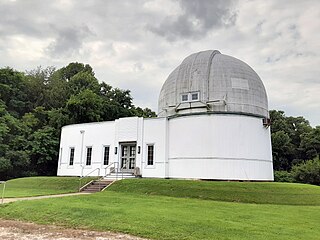
The Goethe Link Observatory, observatory code 760, is an astronomical observatory near Brooklyn, Indiana, United States. It is owned by Indiana University and operated by the Indiana Astronomical Society https://iasindy.org/about.html, which efforts are dedicated to the pursuit of amateur astronomy.
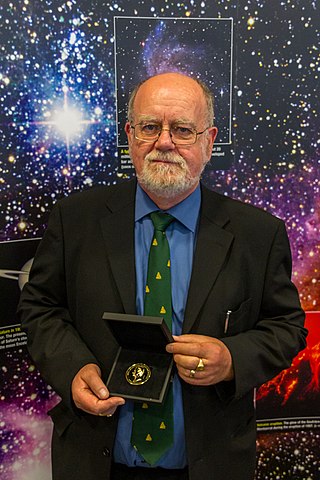
John Campbell Brown was a Scottish astronomer who worked primarily in solar physics. He held the posts of Astronomer Royal for Scotland, the Regius Professor of Astronomy at the University of Glasgow, and honorary professorships at both the University of Edinburgh and the University of Aberdeen.
Jay Myron Pasachoff was an American astronomer. Pasachoff was Field Memorial Professor of Astronomy at Williams College and the author of textbooks and tradebooks in astronomy, physics, mathematics, and other sciences.

Frederick Slocum was an American astronomer. He was the director of Van Vleck Observatory.

Samuel Alfred Mitchell was a Canadian-American astronomer who studied solar eclipses and set up a program to use photographic techniques to determine the distance to stars at McCormick Observatory, where he served as the director.
Gerhart "Gerry" Neugebauer was an American astronomer known for his pioneering work in infrared astronomy.
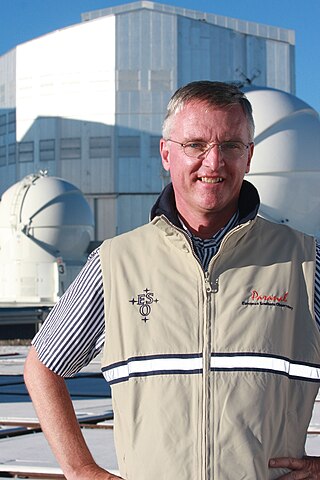
Pieter Timotheus "Tim" de Zeeuw is a Dutch astronomer specializing in the formation, structure and dynamics of galaxies. From 2007 to 2017 he was the director general of European Southern Observatory. He is married to astronomer Ewine van Dishoeck. In May 2022, Leiden University suspended him after an internal review concluded that over several years he repeatedly belittled and insulted women in public and abused his position of power as a professor by threatening to damage their scientific careers; and that in addition to intimidation and inappropriate behavior there was "a component of sexual harassment". The Max Planck Institute for Extraterrestrial Physics announced that they will no longer work with him and the European Southern Observatory banned him from accessing their premises.
Jerry Earl Nelson was an American astronomer known for his pioneering work designing segmented mirror telescopes, which led to him sharing the 2010 Kavli Prize for Astrophysics.

Claudia Megan Urry is an American astrophysicist, who has served as the President of the American Astronomical Society, as chair of the Department of Physics at Yale University, and as part of the Hubble Space Telescope faculty. She is currently the Israel Munson Professor of Physics and Astronomy at Yale University and Director of the Yale Center for Astronomy and Astrophysics. Urry is notable not only for her contributions to astronomy and astrophysics, including work on black holes and multiwavelength surveys, but also for her work addressing sexism and sex equality in astronomy, science, and academia more generally.
John Wainwright Evans was an American solar astronomer born in New York City. He spent much of his career studying the sun and working with optics both of which earned him awards. The Evans Solar Facility at Sacramento Peak was named after him. Evans died in a murder–suicide with his wife in 1999.
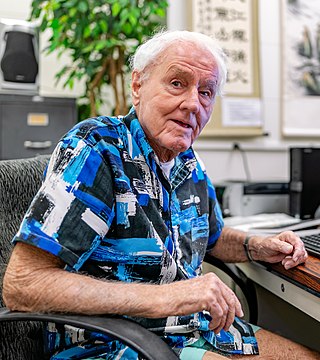
Helmut Arthur Abt is a German-born American astrophysicist, having worked at the National Optical Astronomy Observatory and an Elected Fellow of the American Association for the Advancement of Science. He is astronomer emeritus at Kitt Peak National Observatory.
Charles Morse Huffer was an American astronomer and instructor.
Harvey Washington Banks was a professor of physics and astronomy at Howard University and was the first African American to earn a doctorate specifically in the field of astronomy.
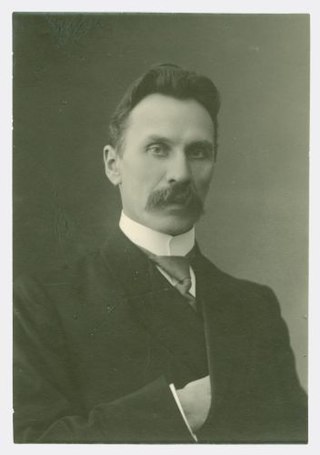
Konstantin Dorimedontovich Pokrovsky was a Soviet astronomer, corresponding member of the Academy of Sciences of the Soviet Union, and Professor. He was a rector of the Perm Branch of the Imperial Petrograd University (1916–1917), and the first rector of Perm State University (1917–1918).
Eileen Dolores Friel is an American astronomer specializing in the metallicity of star clusters. She is a former director of the Maria Mitchell Observatory and Lowell Observatory, and a professor emeritus of astronomy at Indiana University.

Harm Jan Habing is a Dutch astronomer and emeritus professor of astrophysics at Leiden University.













